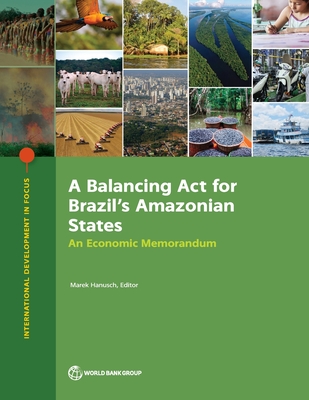Balancing ACT for Brazil's Amazonian States: An Economic Memorandum

Balancing ACT for Brazil's Amazonian States: An Economic Memorandum
Brazil's nine Amazonian states, here collectively referred to as Amazônia, include some of the world's richest ecosystems, including the Amazon rainforest and parts of the Cerrado savanna and Pantanal wetlands. The region is also among Brazil's poorest socioeconomically. As a result, sustainable, inclusive development of Amazônia calls for raising living standards while protecting natural forests. A Balancing Act
for Brazil's Amazonian States: An Economic Memorandum explores how a recalibrated development approach can achieve these goals.
In the shorter term, there is an urgent need to halt deforestation--a massive destruction of natural wealth that poses risks to the climate and economy. Amazônia is Brazil's deforestation hot spot, and the Amazon rainforest is approaching tipping points into broad and permanent forest loss. Reversing the recent increase in deforestation requires stronger land and forest governance, including land regularization and more effective law enforcement.
In the longer term, both Brazil and Amazônia need a new growth model. This model would be anchored in productivity rather than resource extraction and it would diversify the export basket beyond commodities. A more balanced structural transformation requires the lagging urban sectors, such as manufacturing and services, to step up to promote economic growth, reduce pressure on the agricultural frontier, and generate jobs for Brazil and Amazônia's largely urban populations. The public-good value of Amazônia's forests could generate conservation finance linked to verifiable reductions in deforestation. Such financing would support a new development approach, combining forest protection, productivity, balanced structural transformation, sustainable production techniques (including the bioeconomy), and other measures to address the needs of Amazônia's urban and rural populations. This approach must also heed the needs and interests of Amazônia's traditional communities.
Given both the value and the fragility of Amazônia's ecosystems, coupled with considerable socioeconomic local needs, the stakes are high-for Amazônia, Brazil, and the world.
PRP: 519.79 Lei
Acesta este Pretul Recomandat de Producator. Pretul de vanzare al produsului este afisat mai jos.
441.82Lei
441.82Lei
519.79 LeiIndisponibil
Descrierea produsului
Brazil's nine Amazonian states, here collectively referred to as Amazônia, include some of the world's richest ecosystems, including the Amazon rainforest and parts of the Cerrado savanna and Pantanal wetlands. The region is also among Brazil's poorest socioeconomically. As a result, sustainable, inclusive development of Amazônia calls for raising living standards while protecting natural forests. A Balancing Act
for Brazil's Amazonian States: An Economic Memorandum explores how a recalibrated development approach can achieve these goals.
In the shorter term, there is an urgent need to halt deforestation--a massive destruction of natural wealth that poses risks to the climate and economy. Amazônia is Brazil's deforestation hot spot, and the Amazon rainforest is approaching tipping points into broad and permanent forest loss. Reversing the recent increase in deforestation requires stronger land and forest governance, including land regularization and more effective law enforcement.
In the longer term, both Brazil and Amazônia need a new growth model. This model would be anchored in productivity rather than resource extraction and it would diversify the export basket beyond commodities. A more balanced structural transformation requires the lagging urban sectors, such as manufacturing and services, to step up to promote economic growth, reduce pressure on the agricultural frontier, and generate jobs for Brazil and Amazônia's largely urban populations. The public-good value of Amazônia's forests could generate conservation finance linked to verifiable reductions in deforestation. Such financing would support a new development approach, combining forest protection, productivity, balanced structural transformation, sustainable production techniques (including the bioeconomy), and other measures to address the needs of Amazônia's urban and rural populations. This approach must also heed the needs and interests of Amazônia's traditional communities.
Given both the value and the fragility of Amazônia's ecosystems, coupled with considerable socioeconomic local needs, the stakes are high-for Amazônia, Brazil, and the world.
Detaliile produsului









